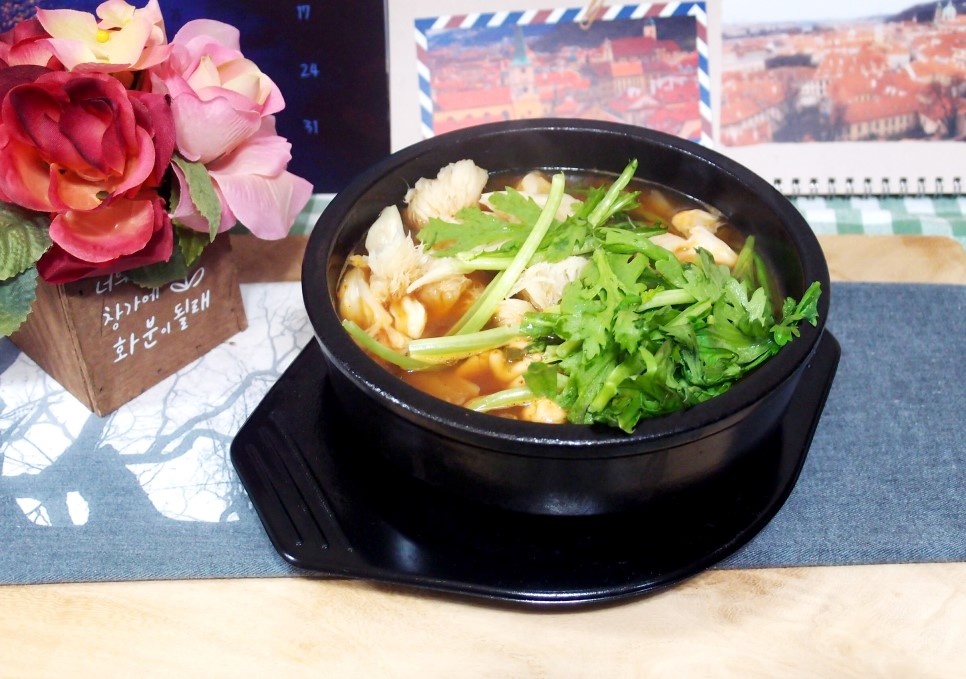Spicy and Refreshing Cod Roe Stew (Altang)
When You Crave a Warm and Spicy Broth on a Cold Winter Day! Making Premium Altang with Mushrooms and Crown Daisy

This is a spicy and refreshing Altang made with fresh pollack roe and gonier (pollack milt), seasoned with gochugaru (chili powder) and fish sauce in a rich broth, generously flavored with aromatic mushrooms and crown daisy.
Altang Ingredients- 1 pack fresh pollack roe
- 1 pack fresh gonier (pollack milt)
- 1L natural broth for a deep flavor
- 1/2 onion, sliced
- 1 piece daikon radish
- 1 cup mushrooms
- 1 cup crown daisy (ssukgat)
- 1 Tbsp minced garlic
- 2 Tbsp chopped scallions
- 3 Tbsp gochugaru (Korean chili powder)
- 1 Tbsp Cheongju (rice wine) for removing gaminess
- 2 Tbsp fish sauce for umami
- 1/2 cup frozen seafood mix
Cooking Instructions
Step 1
First, we’ll carefully make the broth, which is crucial for the depth of flavor in your Altang. Place kelp, dried shiitake mushrooms, and other natural flavoring ingredients into a stock bag. Add the dried scallion roots – these add a deep, savory aroma to the broth. It’s best to buy scallions with roots, wash them thoroughly, dry them in the sun, and then freeze them for future broth-making.

Step 2
Don’t throw away the heads of shrimp when you cook with fresh shrimp! Save them in the freezer and add them to your broth. Shrimp heads contribute an incredibly rich and savory flavor, creating a more delicious broth than you can imagine. Add 2 shrimp heads to the stock bag along with the natural flavoring ingredients and shiitake mushroom stems, then bring it to a boil.

Step 3
To achieve the richest flavor, simmer the broth over medium heat. If you’re short on time, you can boil it rapidly over high heat and then strain it. However, I always prefer to simmer it slowly over medium heat to bring out the best possible taste.

Step 4
As the broth simmers, skim off any foam that rises to the surface to ensure a clear and clean broth. Once the broth ingredients have done their job, remove them. Instead of discarding them, you can store them in the refrigerator for about a day and reuse them as broth for ramen or somyeon (thin wheat noodles) the next day. Now, add the chopped scallions and minced garlic to the finished broth to enhance its fragrance.

Step 5
Here are the fresh pollack roe and gonier I purchased from the market. Ensure they are clean and well-prepared before adding them to the stew.

Step 6
Carefully add the prepared pollack roe and gonier to the rapidly boiling broth. It’s best to maintain a medium heat while cooking to prevent them from breaking apart, ensuring a firm and pleasant texture.

Step 7
Add the sliced onion and daikon radish to bring a refreshing sweetness and depth. Thinly sliced daikon will become tender quickly, offering a soft texture. If you prefer thicker cuts of radish, it’s a good idea to add them when making the broth initially, as this will infuse the broth with the radish’s refreshing flavor.

Step 8
To make the stew even more satisfying, I’ve added a mix of frozen seafood to supplement the pollack roe and gonier. This adds a variety of textures and a richer seafood flavor. It also helps if the initial freshness of the roe and gonier isn’t as high as hoped.

Step 9
Next, add the gochugaru for a spicy kick. The stew is seasoned primarily with fish sauce for a clean taste. Since garlic and scallions are already in the broth, you won’t need a lot of other seasonings. For an even deeper umami flavor, you can mix fish sauce and soy sauce in a 1:1 ratio.

Step 10
Prepare the mushrooms and crown daisy, which will be added last. These ingredients only need a brief simmer right before serving. The residual heat will cook them perfectly, preserving their fresh aroma and crisp texture.

Step 11
Ladle the well-simmered Altang into individual serving bowls, arranging the mushrooms and crown daisy attractively on top. The warmth of the bowls will gently cook the greens, releasing their fragrant aroma.

Step 12
And there you have it – a premium Altang, brimming with the rich broth, tender pollack roe and gonier, and fresh vegetables, delivering a wonderfully spicy and refreshing taste! Reheat it just before serving at the table for a piping hot stew that will warm you from the inside out.




